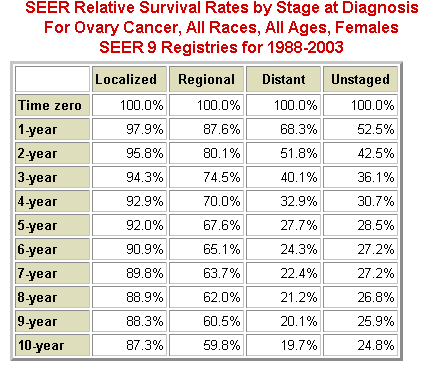There is evidence that the cure rates for
ovarian cancer are improving:
|
Year Interval |
5 Year Survival |
|
1988 - 1991 |
33% |
|
1992 - 1996 |
45% |
|
1997 - 2001 |
53% |
 |
Cancers of the ovary include celomic epithelial carcinomas, germ cell neoplasms, and
stromal tumors. Celomic epithelial carcinomas, however, account for 90% of these lesions
and for most of the clinical research into the management of ovarian cancer.
|
Etiology and risk factors
The etiology of ovarian carcinoma is not known, although certain factors associated with a
higher risk of developing the disease have been identified. There is an association
between uninterrupted ovulation and the disease.There is also an association between
family history and increased risk. Data now suggest that women with one first-order
relative with ovarian carcinoma have a risk 3.6-fold higher than that of the
general population. For those who have two or more relatives with ovarian carcinoma, at
least one of whom is a first-order relative, risk is estimated to be at least 4.6-fold
higher. For those with true familial syndromes by genetic testing (BRCA1) or genetic
linkage studies, risk is considerably higher, with estimates as great as 50% reported but
not necessarily substantiated. These hereditary syndromes include hereditary
breast-ovarian cancer syndrome, hereditary ovarian cancer syndrome, and the Lynch II
syndrome (associated with colon cancer). These syndromes typically appear at a younger age
than sporadic ovarian carcinoma and appear to be vertically transmitted by an autosomal
dominant mode with incomplete penetrance.
The practical implications of these observations are not clear. Insufficient data exist to
justify prophylactic oophorectomy because not all of the tissue at risk (the celomic
epithelial lining of the peritoneal cavity) would be removed by this procedure. Similarly,
no screening techniques of proven efficacy are available, although serum CA 125 levels and
transvaginal sonography are under investigation.
Initial presentation and approach
Patients with celomic epithelial carcinomas initially have feelings of fullness or
heaviness in the pelvis or increasing abdominal girth. These symptoms unfortunately
reflect advanced disease. Efforts to detect the disease earlier have been unsuccessful.
Initial evaluation of patients with suspected ovarian carcinoma, after obtaining the
patient history, a physical examination, laboratory testing, and CA 125 levels, should
include a detailed assessment of the abdominal cavity. Various imaging techniques for the
abdomen are now available, but none provides the detail necessary to accurately stage
ovarian carcinoma. Nevertheless, CT scanning of the abdominal cavity, chest
roentgenography, and bone scanning should be done.
Unless these measures reveal disease outside the abdominal cavity, exploratory laparotomy
is essential. The laparotomy should be done through an incision adequate to evaluate the
entire peritoneal surface, including the undersurface of the diaphragm and the right
paracolic gutter as well as the para-aortic lymph nodes. If there is no evidence of gross
disease outside the pelvis, multiple biopsies of the peritoneal surface should be
performed. Accurate staging of the disease will direct urther management.
Prognostic factors
The most significant prognostic factors for ovarian carcinoma are age, histologic type and
grade, extent of disease (stage), and volume of residual disease. The most important among
these is the extent of disease (stage) at diagnosis. Almost 75% of patients will present
with advanced (stage III or IV) disease, most with disease confined to the peritoneal
cavity (stage III), reflecting intraperitoneal dissemination as the most common route of
spread.
Management
Advanced disease
Exploratory laparotomy, in addition to establishing the extent of disease, also affords
the first step in therapy. In addition to the diagnostic measures described earlier, the
procedure should include an aggressive attempt at surgical cytoreduction. Patients who
complete surgery with small-volume residual disease (nodules < 2 cm in diameter) have a
higher response rate to chemotherapy and improved survival. The mainstay of treating
advanced disease is chemotherapy. Several chemotherapeutic agents are active against
ovarian carcinoma, the most important of which are the platinum compounds, paclitaxel
(Taxol), and the alkylating agents. The standard of care for first-line therapy is a
combination of paclitaxel plus a platinum compound. In patients with large-volume advanced
disease, this combination yields a response rate of 73%-77%, a clinically complete
response rate of 50%-51%, no gross residual disease at second-look laparotomy in 40%,
progression-free survival of 16.6 to 18 months (median), and overall survival of more than
35-38 months (median). In patients with small-volume residual disease, results should be
even better. Another combination that has been used with somewhat less success is an
alkylating agent plus a platinum compound with or without doxorubicin
Limited disease
Exploratory laparotomy is essential to determine whether disease is confined to the
ovaries and pelvis and permits the classification of low-risk and high-risk patients.
Patients at low risk have a cure rate exceeding 90% with total abdominal hysterectomy,
bilateral salpingo-oophorectomy, and omentectomy; they require no further therapy.
Patients at high risk have a recurrence rate of 40% and should receive adjuvant
platinum-based chemotherapy.
Salvage Therapy
For patients with disease recurrence after initial therapy, appropriate management is
determined by response to initial treatment. Patients who first respond to platinum-based
chemotherapy and have a recurrence more than 6 months after treatment are clinically
platinum sensitive. Repeated platinum-based therapy yields response rates as high as 60%.
In contrast, patients with progressive disease despite platinum-based treatment, with
persistent disease at the conclusion of platinum-based therapy, or with recurrence less
than 6 months after initial treatment are clinically platinum resistant. Treatment should
consist of paclitaxel or, in those who received paclitaxel as initial therapy, oral
etoposide, topotecan, tamoxifen or, in some instances, gemcitabine, liposomal doxorubicin
(Doxil) vinorelbine tartrate (Navelbine) or ifosfamide. These seven agents all have a
demonstrated ability to induce responses in patients with platinum- or
paclitaxel-resistant disease. |

